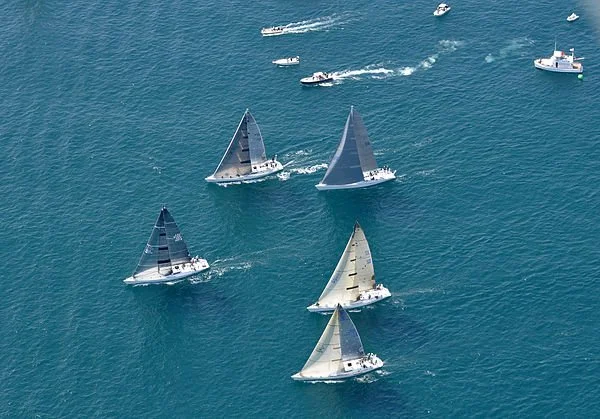From ecoRI News (ecori.org)
While the United States flails about trying to reduce its enormous share of world-altering climate pollution, one part of the transportation/recreational sector is routinely ignored: boating.
Yachting and sailing are steadily gaining in popularity, so an urgency to act is essential if greenhouse-gas emissions are to be significantly reduced.
Yes, sailing burns little fossil fuel, but the resources consumed to build some of these vessels is swelling.
For instance, over the past decade, the carbon footprint of 60-foot International Monohull Open Class Association (IMOCA) racing boats has grown by nearly two-thirds, from 340 to 550 tons — the equivalent of driving an average car 1.4 million miles, according to the 11th Hour Racing Team.
“This is an overall trend we see in pretty much any industry, driven by performance we have accelerated too fast in the wrong direction, and are only just waking up to reality,” according to Damian Foxall, sustainability program manager for the 11th Hour Racing Team. “The need to reduce our emissions in the marine industry is urgent — 50% by 2030, and that’s just eight years away. We are far away from that right now.”
The 11th Hour Racing Team is sponsored by 11th Hour Racing, a Newport, R.I.-based nonprofit that works with the sailing community and maritime industries to “advance solutions and practices that protect and restore the health of our ocean.”
Late last year the team published a report about the importance of building a more sustainable ocean racing boat and better understanding the industry’s environmental impact. It showed performance doesn’t need to be sacrificed to build a more environmentally friendly boat.
“Business as usual is no longer an option. While the performance sailing sector and much of the leisure marine industry is geographically centered in the global North and a few other well-off regions, we live in a fragile bubble of prosperity,” according to the report. “This alternative reality does not reflect either the reality for most of the world’s citizens, or the availability of the earth’s resources.
“Inherently tied to the ongoing growth of global economies, we would need 1.7 Earths each year just to maintain the situation for the average global citizen. Scaled to the typical lifestyles associated with the marine industry this is more like 5+ Earths each year: a growing annual debt,” the report says.
The 128-page report includes a detailed study of material life cycles and alternative composites, such as flax to replace ubiquitous virgin carbon fiber. About 80 percent of greenhouse gas emissions in a boat build are associated with the use of composite materials, most notably carbon fiber, which is perfect for racing because it is light and stiff. Reducing the use of this material and others would significantly lessen climate emissions tied to the building of a new racing boat, according to the 11th Hour Racing Team.
In fact, the 11th Hour Racing Team and its partners are advocating for radical change across the marine industry to transform the way boats are built. They believe that only by “prioritizing sustainability along with performance, can the marine industry take urgent action to fight climate change.”
Foxall recently told ecoRI News that sustainable sourcing and using as much renewable energy as possible are the two biggest things racing teams can do right now to lower their carbon footprints.
The 11th Hour Racing Team, for instance, now leases an electric support vessel during races, which has lowered climate emissions from both a transportation and manufacturing perspective.
Foxall said rule changes would require sailing teams to incorporate more sustainable materials into their design and build. He noted, for example, reused carbon fiber is mostly avoided because the virgin material makes for better performance. But if rules required every team to use recycled fiber, no team would have an advantage.
“In our sport, rules define what the boats are … as much as one team or a couple of teams or even an event might want to improve the footprints, that cannot happen until the rules incentivize it,” Foxall said. “And the rules for the longest time have incentivized performance, whether it is carrying more sacks of coal or corn from Australia to Europe or transporting more people from Europe to North America or now racing faster and going faster through the water. It’s all about performance.”
He added the sport can no longer “just make decisions based purely on performance. We need to be taking into account the direct and indirect impacts” on the environment.
The December report recommends establishing minimum standards on sourcing, energy, waste, and resource circularity; defining a threshold for carbon emissions based on life cycle assessment (LCA) data; incentivizing the marine industry to use its inherent capacity for innovation to focus on sustainability; and setting an internal price for carbon emissions.
Amy Munro, sustainability officer for the 11th Hour Racing Team, noted the building of a racing boat is a complex process involving a number of stakeholders, materials, and components.
“You need to break it down in detail to fully understand what are the major impacts,” according to Munro. “This is why we have meticulously measured the impact of every step in the design and build process of our new boat and conducted a life cycle analysis that helps to uncover underlying issues.”
Last month, Charlie Enright, 11th Hour Racing Team skipper, spoke at the U.N.-supported One Ocean Summit in Brest, France, to highlight key findings of the organization’s “Sustainable Design and Build Report,” notably the importance of industry-wide collaboration to push sustainable innovation to align with the Paris Agreement.
“Within our sport, for too long we have chased performance over a responsibility for the environment and people,” the Bristol, R.I., native told an audience of experts, politicians, activists, and decision-makers. “We must work together to reduce the impact of boat builds, adopt the use of alternative materials like bio-resins and recycled carbon, lobby for a change to class and event rules to reward sustainable innovations, and support races and events that are managed with a positive impact on our planet and people.”
Foxall noted about 50 percent of sailors are onboard when it comes to making their sport more sustainable. He said it is their responsibility to bring the others up to speed about the impacts of the climate crisis.
In an email to ecoRI News, Enright noted the sport’s awareness of climate and environmental issues is “definitely increasing.” He said big events such as The Ocean Race and the Transat Jacques Vabre have “strong sustainability policies” in place, including plastic-free race villages, onboard waste calculation initiatives, and efforts to educate teams and fans about these matters. “This is relatively new in our sport.”
The Ocean Race also runs an ocean science program in partnership with 11th Hour Racing, collecting data on water temperature, salinity, and other potential climate change impacts. The Transat Jacques Vabre uses the 11th Hour Racing Team’s Sustainability Toolbox, which, among other things, commits to efforts to limit waste, use renewable energy and reduce emissions wherever possible, as a framework for its own sustainability program.
“Of course there are those who need a bit more convincing on the importance of it,” Foxall said. “But, quite frankly … kids coming home from school today know what the issue is.”
In 2019, greenhouse-gas emissions from ships and boats in the United States alone totaled 40.4 million metric tons of carbon dioxide equivalent. Globally, bulk carriers are the main source of shipping/boating climate emissions. Some 90 percent of world trade is carried across the world’s oceans by some 90,000 marine vessels. Carbon dioxide emissions from these vessels are largely unregulated.
Last year, the Environmental Protection Agency (EPA) did adopt exhaust emission standards for marine diesel engines installed in a variety of marine vessels, ranging in size and application from small recreational boats to large ocean-going ships.
While the shipping industry is responsible for a significant proportion of global climate emissions — if global shipping were a country, it would be the sixth-largest producer of greenhouse gases behind China, the U.S., Russia, India and Japan — the climate impacts of the recreational powerboat industry, most notably yachts, are considerable.
The propulsion systems on many yachts are arguably the least-efficient modes of transportation ever devised. The typical 40- to 50-foot yacht guzzles fuel.
U.S. recreational boaters spend about 500 million hours annually cruising fresh and salt waters. In 2010, more stringent EPA emissions standards for marine engines, both in-board and outboard, went into effect. But, unlike cars, private boats are not inspected. They can be checked by the Coast Guard or law enforcement, but there is no annual emissions check.
Many recreational boats and some jet-propelled watercraft have two-stroke engines. Conventional two-stroke engines produce about 14 times as much climate pollution as four-stroke engines.
Last year new U.S. powerboat sales surpassed 300,000 units for the second consecutive year, closing 2021 about 6 percent below record highs in 2020 and some 7 percent above the five-year sales average, according to the National Marine Manufacturers Association. In 2020, annual U.S. sales of boats, marine products and services totaled $49.3 billion, up 14 percent from 2019.
The oceans play an essential role in keeping atmospheric carbon dioxide in balance by absorbing about 30 percent of the CO2 that is released, from all sources. This blue carbon sink, however, has been working overtime since the Industrial Revolution began belching fossil fuels into the atmosphere.
The ocean, though, can only swallow so much of this colorless gas. When carbon dioxide is absorbed by seawater, chemical reactions occur that increase the acidity of the water through a process known as ocean acidification.
Acidifying marine waters are bad news for marine life with calcium carbonate in their shells or skeletons, such as oysters, corals, crabs, scallops, and mussels. Studies have found that more acidic salt waters make it more difficult for them to develop their hardened protection.
As of early last month, the recorded amount of carbon dioxide in the atmosphere was a tick away from 418 parts per million (ppm) — well beyond the 350 ppm that climate scientists have deemed safe for humans, never mind most of the planet’s other living inhabitants.
“While the situation is extremely urgent and ‘business-as-usual’ is clearly no longer an option, it is still technically possible to close your eyes and look away,” Enright wrote. “This is why we have to act now and we have to create our own pressure. What we need is a radical change and one of the most important parts here is that the marine industry works together to achieve it.”
Frank Carini is co-founder and senior reporter of ecoRI News.























